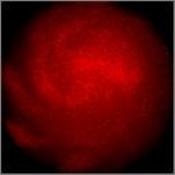Sep 2 2010
For the casual observer it is fascinating to watch the orderly and seemingly choreographed motion of hundreds or even thousands of fish, birds or insects. However, the formation and the manifold motion patterns of such flocks raise numerous questions fundamental to the understanding of complex systems.
A team of physicists from Technische Universitaet Muenchen (TUM) and LMU Muenchen has developed a versatile biophysical model system that opens the door to studying these phenomena and their underlying principles. Using a combination of an experimental platform and theoretical models, more complex systems can now be described and their properties investigated. The Munich researchers report on their findings in the current issue of the renowned journal Nature.
"Everything flows and nothing abides," is a saying ascribed to the Greek philosopher Heraclitus. Large groups of individuals may show collective behavior where the individuals' actions appear to be coordinated or even subordinated to the common good: Flocks of birds move through the air without a conductor, as if they were choreographed, and shoals of fish change their direction instantaneously when a shark appears. Yet science is still puzzled: Do all these systems obey the same universal laws? Does complex group behavior emerge from simple interactions between individuals intrinsically and inevitably? A team of researchers headed by Professor Andreas Bausch, Chair of Biophysics at TUM and Professor Erwin Frey, Chair of Statistical and Biological Physics at LMU, are unraveling the mystery.
 The Munich researchers have developed a biophysical model system that makes it possible to carry out targeted high-precision experiments under controlled conditions.
The Munich researchers have developed a biophysical model system that makes it possible to carry out targeted high-precision experiments under controlled conditions.
The Munich researchers have developed a biophysical model system that makes it possible to carry out targeted high-precision experiments under controlled conditions. To this end, Volker Schaller from the TUM Chair of Biophysics, first author of the study, fixed biological motor proteins to a microscope coverslip in such a way that they could drive filaments of the muscle protein actin, suspended loosely over them, in any direction. The filaments measure about seven nanometers across, i.e. seven millionths of a meter, and are about ten micrometers long, i.e. a ten thousandth of a millimeter. The movement of the filaments is visualized using high-resolution microscopy.
In the experiments described in Nature, the actin filaments began to move as soon as ATP – the fuel for the motor proteins – was added. With low concentrations of actin filaments, the motion remained completely chaotic. Once the density crossed a threshold of five actin filaments per square micrometer, the filaments began to move collectively in larger clusters – with an astonishing resemblance to flocks of birds or shoals of fish. "We can set and observe all relevant parameters in this system," says Schaller. "Using this approach, we can experimentally test the propositions of different theories on self-organization – and that on the tiny scale of 'nanomachines'."
Structures like waves, swirls or ordered clusters seem to appear spontaneously during the experiments. Some of these structures grow to a size of almost one millimeter and remain stable for up to 45 minutes before they dissolve again. Based on these observations, Frey, together with his PhD student Christoph Weber, developed theoretical models to describe the experimental results. With the combination of extensible theoretical models and a precisely controllable experiment, the physicists have set out to tackle more difficult problems and unravel their underlying principles.
"Self-organization phenomena surround us on all levels of our lives," says Bausch. "It begins with traffic jams and the movement of human crowds or the swarming of animals and extends all the way to the organization of biological processes. Important examples are the formation of the cellular cytoskeleton or protein transport facilitated by motor proteins in cells." The underlying principles, though – whether in economic, biological or physical systems – are still among the great open questions of theoretical physics. "For our understanding of nature, as well, there are many fundamental principles yet to be discovered," emphasizes Frey. "However, forecasts should not be applied to the dynamics of human crowds over-hastily – thus far, their complexity is much too great to be captured in simple theoretical models."
Source: http://portal.mytum.de/